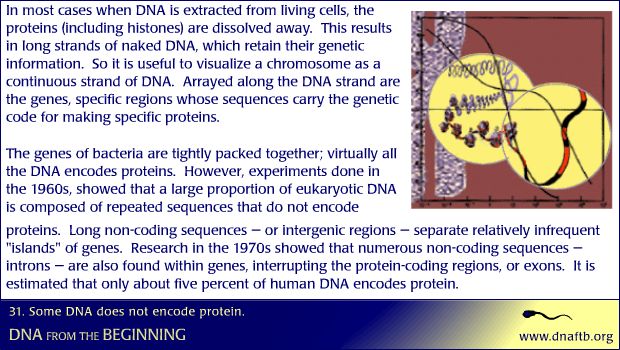Some DNA does not encode protein.

Long non-coding sequences separate relatively infrequent islands of genes in eukaryotic DNA.
In most cases when DNA is extracted from living cells, the proteins (including histones) are dissolved away. This results in long strands of naked DNA, which retain their genetic information. So it is useful to visualize a chromosome as a continuous strand of DNA. Arrayed along the DNA strand are the genes, specific regions whose sequences carry the genetic code for making specific proteins. The genes of bacteria are tightly packed together; virtually all the DNA encodes proteins. However, experiments done in the 1960s, showed that a large proportion of eukaryotic DNA is composed of repeated sequences that do not encode proteins. Long non-coding sequences — or intergenic regions — separate relatively infrequent "islands" of genes. Research in the 1970s showed that numerous non-coding sequences — introns — are also found within genes, interrupting the protein-coding regions, or exons. It is estimated that only about five percent of human DNA encodes protein.
genes, dna strand, naked dna, eukaryotic dna, intergenic regions, non-coding sequences, introns, exons, histones, genetic code, chromosome, sequences, proteins, bacteria
- ID: 16656
- Source: DNALC.DNAFTB
Related Content
16528. Concept 24: The RNA message is sometimes edited.
RNA splicing removes non-coding introns and splices together exons.
16933. 3D Animation of DNA to RNA to Protein
An animation shows how the DNA genetic "code" is made into protein.
16938. 3D Animation of RNA Splicing
An animation of the crucial RNA editing step called splicing.
15549. Transcription/translation - Exons and introns
In most eukaryotic genes, coding regions (exons) are interrupted by noncoding regions (introns).
16932. Flow of Information from DNA to RNA to Protein
Dr. Roberts describes the flow of information from DNA to RNA to protein.
16626. Concept 29: DNA is packaged in a chromosome.
Each chromosome is a package for one very long, continuous strand of DNA.
16657. Some DNA does not encode protein.
DNAFTB Animation 31: Roy Britten presents his work with David Kohne on repetitive DNA and its evolutionary origins.
16834. Animation 40: Living things share common genes.
Mike Wigler shows how all organisms share similar genes, called homologs.
16705. Animation 34: Genes can be moved between species.
Stanley Cohen and Herbert Boyer transform bacteria with a recombinant plasmid, and Doug Hanahan studies induced transformation.
16529. Animation 24: The RNA message is sometimes edited.
Rich Roberts and Phil Sharp explain restriction enzymes, electrophoresis, and split genes.












